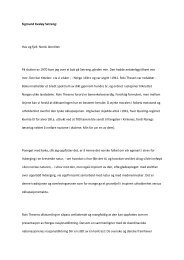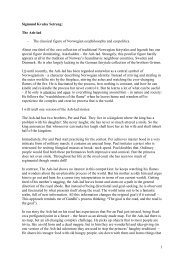The Healing Power of Nature - Norwegian Journal of Friluftsliv
The Healing Power of Nature - Norwegian Journal of Friluftsliv
The Healing Power of Nature - Norwegian Journal of Friluftsliv
You also want an ePaper? Increase the reach of your titles
YUMPU automatically turns print PDFs into web optimized ePapers that Google loves.
<strong>of</strong> work clinical. Both economic and satisfaction benefits are achieved.<br />
People in more urbanized and built communities are beginning to realize the impact <strong>of</strong> natural<br />
landforms and how they influence human health and wellbeing. As some humans become more<br />
separate from nature they don’t reliably consider the potential power <strong>of</strong> nature in relationship to the<br />
built environment. However, a number <strong>of</strong> recent disasters have provoked more research in the area <strong>of</strong><br />
land forms and disaster prevention, warning, mitigation, and recovery. All natural disasters and hazards<br />
cannot be avoided, but appropriate use <strong>of</strong> nature and natural landforms can lessen human vulnerability.<br />
Two brief examples: Two hotels on a beach in Sri Lanka were in the path <strong>of</strong> the 2004 Tsunami. One hotel<br />
had removed the natural sand barrier in order to have a better view and access to the water and over<br />
100 people died in this hotel. A second hotel was behind a natural sand barrier and lost only a few<br />
people. As a result <strong>of</strong> a 2004 hurricane that hit neighboring countries, Haiti and the Dominican Republic,<br />
massive amounts <strong>of</strong> water was released on the land at one time. In Haiti, deforested by mining, this<br />
excessive water caused massive landslides and over 6,000 deaths. Neighboring Dominican Republic, still<br />
largely forested benefited from the ability <strong>of</strong> the vegetation to stabilize the land and limit their flash<br />
flood problem resulting in relatively few deaths during the aftermath <strong>of</strong> the storm (Ingram, 2009). Trees<br />
not only add in soil stabilization during storms they also help store water. Because <strong>of</strong> deforestation on<br />
Bali water runs <strong>of</strong>f into the ocean instead <strong>of</strong> being stored in large underground basins and used year<br />
round by residents. <strong>The</strong>re a water shortage is expected within ten years. Allowing mangrove to remain<br />
in the saline coastal areas creates protection from storm damage and provides vital habitat for fish used<br />
in human consumption. Understanding how mutually dependent humans are with nature for our<br />
wellbeing might lessen risks <strong>of</strong> drought, food shortages, and direct human injury.<br />
17




